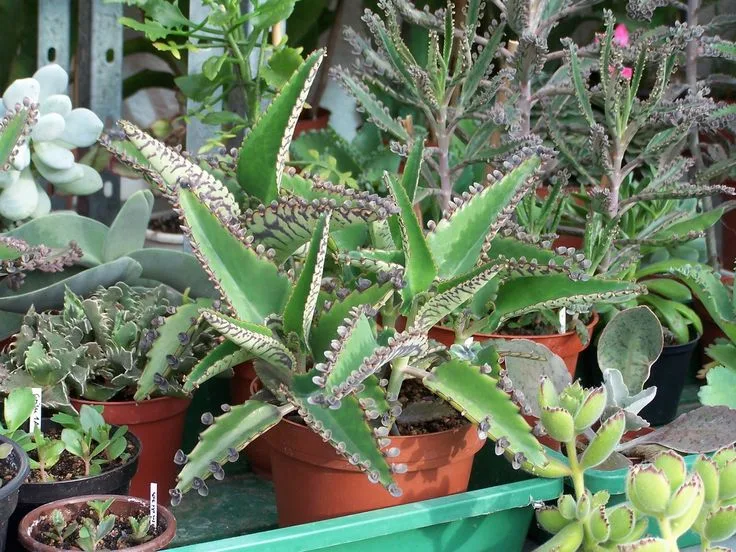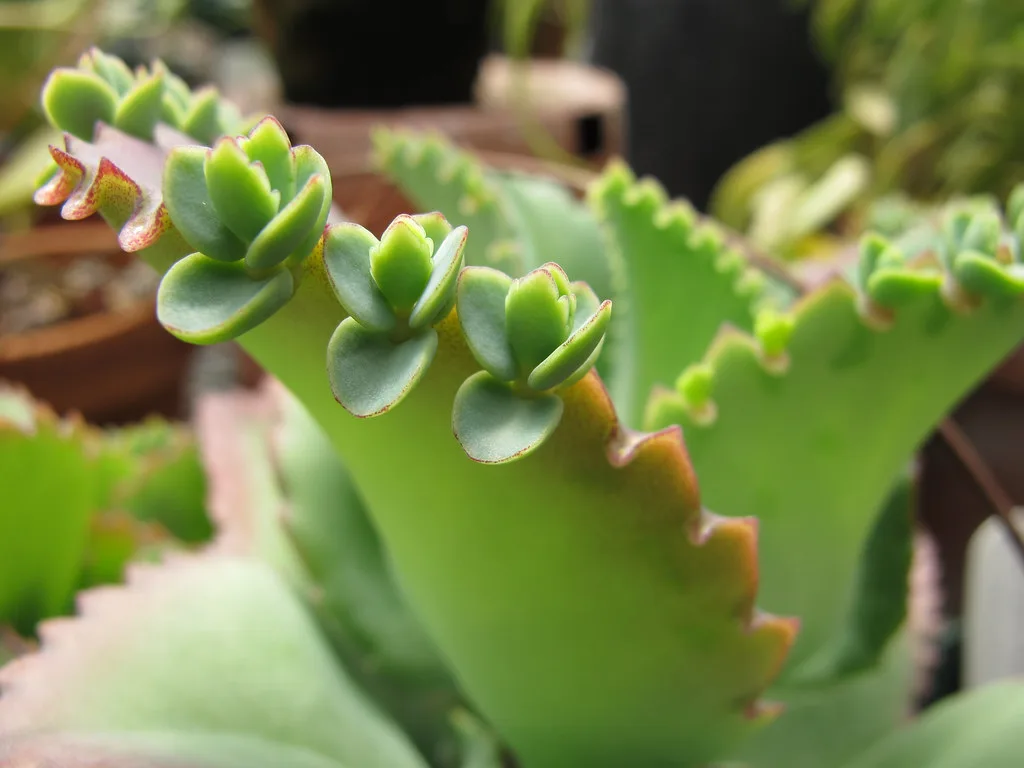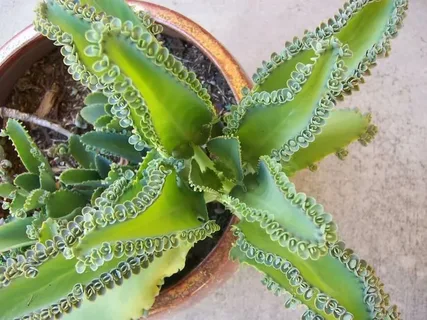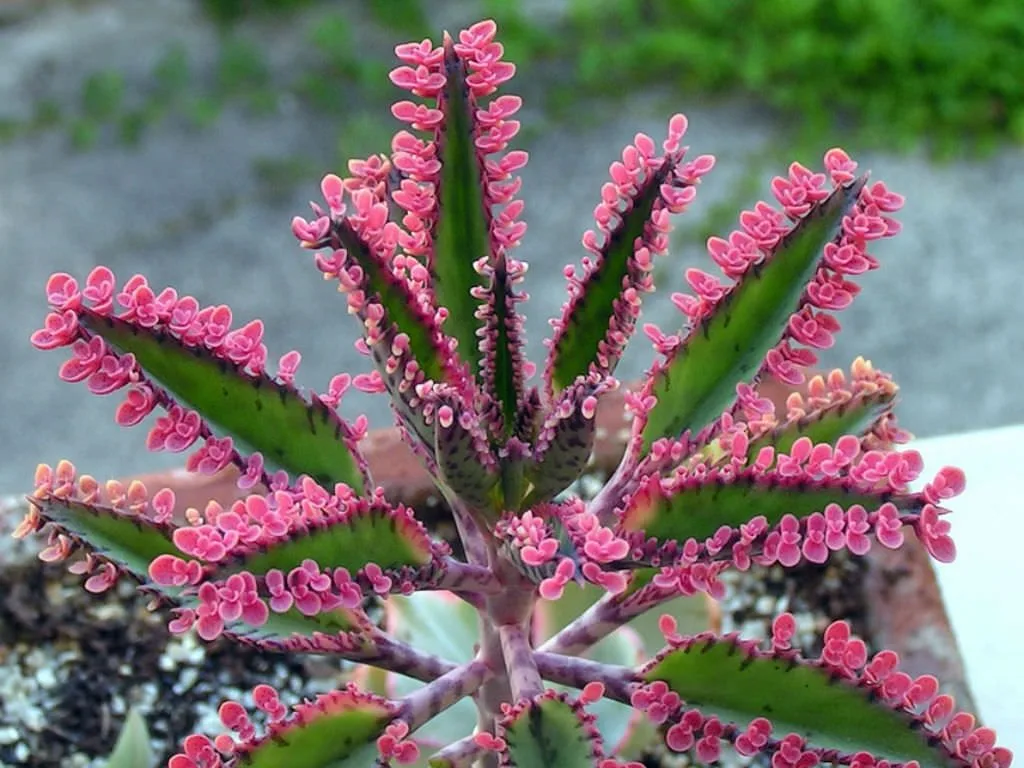Index
Introduction
Succulents have won hearts around the world with their exotic beauty and ease of care, and the Mother of Thousands Succulent is no exception. Also known by the scientific name Bryophyllum daigremontianum, this captivating plant originates from Madagascar and is famous for its unique ability to reproduce on a large scale.
With its fleshy leaves and serrated edges, the Mother of Thousands Succulent presents an enchanting visual spectacle. However, the highlight of this plant lies in its ability to generate new seedlings on its leaves, creating tiny seedlings that resemble thousands of little offspring, hence the evocative name.
Meaning of the Mother of Thousands Succulent
In addition to its remarkable beauty, Bryophyllum daigremontianum carries with it fascinating symbolic meanings. The ability to generate countless seedlings represents the abundance and multiplication of life. In the language of plants, the Mother of Thousands Succulent is often associated with fertility, renewal and prosperity. Cultivated with care, this succulent not only adds an exotic touch to environments, but also brings with it the promise of growth and vitality for those who welcome it into their homes.
| Common Name | Mother of Thousands Succulent |
|---|---|
| Botanical Name | Bryophyllum daigremontianum |
| Family | Crassulaceae |
| Plant Type | Succulent |
| Adult Size | Average height 30 to 60 cm |
| Sun exposure | Full sun |
| Soil type | Well-drained, sandy |
| soil pH | Neutral to slightly acidic (6.0-7.0) |
| Flowering Season | Spring to summer |
| Flower color | Varied, including shades of pink and red |
| Native Area | Madagascar |
| Toxicity | Slightly toxic to pets and humans, due to toxic compounds in the leaves |

How to Care for the Mother of Thousands
If you’re enchanted by the beauty of the Mother of Thousands Succulent, it’s essential to understand the specific needs of this unique plant. Here are some essential tips to ensure that your Bryophyllum daigremontianum blooms and thrives:
Light
Succulents generally love sunlight, and the Mother of Thousands is no exception. Make sure you place your plant in a spot where it receives direct sunlight. However, avoid excessive sun exposure during the hottest hours of the day, as this can cause damage to the leaves.
Soil
The choice of soil is crucial to the successful cultivation of the Mother of Thousands. Opt for well-drained, sandy soil that allows water to drain off easily. This helps prevent root rot, a common concern with succulents.
Watering
Watering succulents requires a careful approach. Let the soil dry out completely between waterings to avoid excess moisture, which can be harmful. The Mother of Thousands is drought-resistant, so it’s best to err on the side of moderation when watering.
Temperature and humidity
Bryophyllum daigremontianum thrives in warm climates and prefers temperatures between 18°C and 25°C. Avoid prolonged exposure to temperatures below 10°C. As for humidity, this succulent is adaptable, but ensuring good ventilation helps prevent fungal diseases.
Fertilizing
Fertilizing the Mother of Thousands is essential to ensure healthy growth. Use a balanced fertilizer during spring and summer, when the plant is at its most active. Reduce fertilization in autumn and winter, when the plant enters a state of relative dormancy.
With these care guidelines, your Mother of Thousands Succulent will be ready to show off all its exuberance and delight everyone who sees it.
How to make Mother of Thousands Succulent cuttings
Making cuttings of the Mother of Thousands is a fascinating and relatively simple process. Follow these steps to ensure successful propagation:
- Choice of Leaves: Select healthy, mature leaves from the mother plant. Make sure there is no significant damage to the chosen leaves.
- Drying: Leave the chosen leaves to air dry for a day or two. This allows the cut ends to heal, reducing the risk of infection.
- Planting: Place the dried leaves in well-drained soil, slightly burying the base of the leaf. Keep the soil slightly moist during the rooting process.
- Seedling development: Over time, small seedlings will begin to develop along the edges of the leaves. Once the seedlings have reached a suitable size, they can be transplanted into their own pots.
How to plant the Mother of Thousands Succulent
Planting the Mother of Thousands in the ground or in a pot is a crucial step in ensuring its healthy growth. Follow these guidelines:
- Choice of Pot/Soil: Use a pot with drainage holes or plant directly in well-drained soil.
- Positioning: Plant the succulent in an area that receives direct sunlight or bright filtered light.
- Transplanting seedlings: If you are planting developed seedlings, dig a small hole in the soil and carefully position the seedling. Cover the roots with soil and water moderately.
- Initial watering: After planting, water lightly to help the plant settle into its new environment.
By following these simple instructions, you’ll be growing not just one, but several Mothers of Thousands, adding beauty and uniqueness to your succulent garden.

Common Problems and Their Solutions
When growing the lovely Mother of Thousands succulent, it’s crucial to be aware of the possible challenges that can arise. Here is a list of common pests and diseases, along with their solutions to keep your plant healthy and lush.
Mealybugs
- Solution: Manually remove mealybugs using a cloth soaked in alcohol. If the infestation is severe, consider applying insecticide.
Mites
- Solution: Wash the affected leaves with water or use neem oil for natural control.
Root rot
- Solution: Make sure the soil is well drained. Reduce the frequency of watering and repot the plant if necessary.
Fungus
- Solution: Improve air circulation around the plant, avoiding excess humidity. Apply fungicides if necessary.
By promptly identifying these problems and implementing the appropriate solutions, you will be providing your Mother of Thousands Succulent with the best conditions to thrive. Vigilance and preventative care are essential to maintaining the beauty and health of this unique plant.
Curiosities and myths
Discover fascinating facts and debunk some myths surrounding the Mother of Thousands Succulent. This additional information is sure to increase your appreciation for this intriguing plant.
Curiosities
- Exceptional reproduction: The Mother of Thousands’ ability to reproduce through its leaves is truly remarkable. A single leaf can give rise to a profusion of seedlings.
- Adaptation to Adverse Conditions: Originally from Madagascar, the plant has developed an incredible ability to survive in challenging climatic conditions, making it robust and hardy.
- Variety of Colors: The flowers of the Mother of Thousands can display a variety of colors, including shades of pink, red and orange. This diversity contributes to its ornamental appeal.
- Cultural Significance: In some cultures, the Mother of Thousands is associated with symbols of prosperity and growth, making it a popular choice in rituals and celebrations.
Myths to debunk
It needs a lot of water
- Reality: The Mother of Thousands is drought-resistant and prefers drier soils. Excessive watering can lead to root rot.
Can Only Be Grown in Warm Climates
- Reality: Although it prefers warmer temperatures, the plant is surprisingly adaptable to different climates, as long as it is protected from extreme temperatures.
Grows quickly without control
- Reality: Although prolific in seedling production, the Mother of Thousands’ growth can be managed by controlling growing conditions and pruning appropriately.
By exploring these curiosities and debunking myths, you will have a more comprehensive understanding of the Mother of Thousands Succulent, making the experience of growing it even more enriching.

Conclusion
To sum up, the Mother of Thousands Succulent, or Bryophyllum daigremontianum, is an extraordinary plant that captivates not only with its unique beauty, but also with its remarkable ability to reproduce prolifically from the leaves. Originally from Madagascar, this succulent adapts to diverse climatic conditions, making it a versatile choice for gardeners and ornamental plant enthusiasts. Its fleshy leaves and serrated edges create a charming look, while its flowers in vibrant shades add a dash of exoticism to the environment. In addition, the Mother of Thousands carries symbolic meanings, being associated with prosperity and fertility in some cultures.
When growing this special plant, it is crucial to pay attention to specific care, such as adequate sun exposure, well-drained soil and moderate watering. Propagation through cuttings also provides a unique opportunity to expand your succulent collection. However, as with any crop, the Mother of Thousands can face challenges such as mealybugs, spider mites and root problems, requiring an attentive approach to ensure its health. Having debunked a few myths, it’s clear that this succulent can be grown successfully in a variety of environments, as long as the ideal conditions are provided. In short, by appreciating the Mother of Thousands, we not only enjoy its unique beauty, but also celebrate nature’s incredible ability to renew itself and thrive.
Frequently Asked Questions
How to take care of the Succulent mother of thousands?
Proper care for the mother plant of thousands involves attention to several aspects. This succulent thrives in environments with direct or filtered sunlight, requiring well-drained soil and moderate watering. Keeping the temperature between 18°C and 25°C, as well as applying balanced fertilizer in spring and summer, contributes to its healthy growth.
How often to water the Succulent mother of thousands?
Ao regar a mãe de milhares, a moderação é chave. Permitir que o solo seque entre as regas é fundamental para evitar o apodrecimento das raízes. A frequência de rega deve ser ajustada de acordo com as condições climáticas e a umidade do solo, garantindo um equilíbrio adequado para o desenvolvimento saudável da planta.








